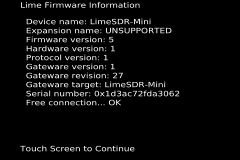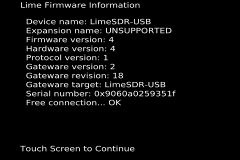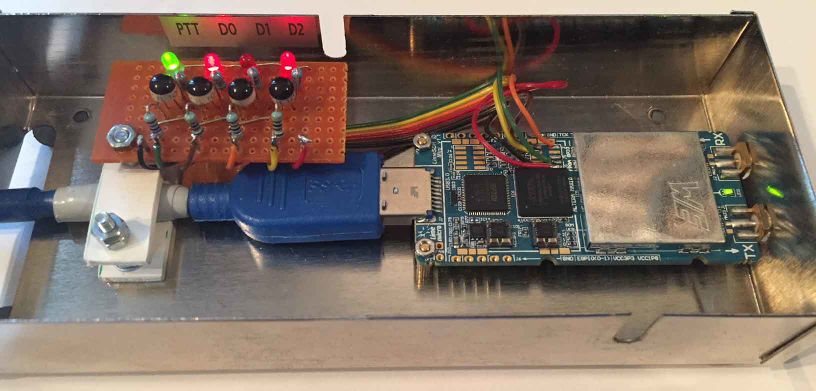Difference between revisions of "Using LimeSDR with Portsdown"
| Line 17: | Line 17: | ||
The "Lime Config" Menu is selected from Menu 3. | The "Lime Config" Menu is selected from Menu 3. | ||
| − | Selecting " | + | Selecting "LimeUtil Info" displays the current version of LimeSuite. The "Update Lime FW" button updates the Lime SDR firmware and gateware to the appropriate version for the installed LimeSuite. For Portsdown software version 201811300 these versions are shown below. You should see exactly the same screen after selecting "Lime FW Info". |
| + | |||
| + | [[File:LimeSDR-Mini.jpg|240px]][[File:LimeSDR-USB.jpg|240px]] | ||
The Lime firmware/gateware version that works with the Portsdown also works with the current version of DATV Express. | The Lime firmware/gateware version that works with the Portsdown also works with the current version of DATV Express. | ||
| − | |||
| − | |||
===Transmitting=== | ===Transmitting=== | ||
Revision as of 16:14, 28 November 2018
Introduction
Being updated for upcoming release 201811300
Software version 201811300 introduces support for the Lime SDR Mini and the Lime SDR USB. Due to the limited CPU power of the Raspberry Pi, many LimeSDR transmit modes are limited to 1MS and below. For higher SRs, use of the Portsdown Filter-modulator board is recommended.
Powering the Lime
The LimeSDR (both Mini and USB versions) has a greater power consumption than the RPi can comfortably power from its USB Port, so a powered USB Hub should be used to provide power to the Lime.
Installing the Lime Software
The LimeSuite software version 18.10.0 is loaded as part of the normal Portsdown build and update process. Once installed, you can use your Portsdown to update the firmware and gateware on your LimeSDR (Mini or USB) to the compatible version.
Lime Configuration Menu
The "Lime Config" Menu is selected from Menu 3.
Selecting "LimeUtil Info" displays the current version of LimeSuite. The "Update Lime FW" button updates the Lime SDR firmware and gateware to the appropriate version for the installed LimeSuite. For Portsdown software version 201811300 these versions are shown below. You should see exactly the same screen after selecting "Lime FW Info".
The Lime firmware/gateware version that works with the Portsdown also works with the current version of DATV Express.
Transmitting
Select Lime Mini or Lime USB from the "Output to" Menu. The detected device should be "not greyed out". Om Menu 1, you will see the Lime Gain button for the appropriate band (distinct Lime Gains between 0 and 100 are stored for each band). This has yet to be calibrated, but I suggest that settings of over 90 risk distortion in the Lime final amplifier.
Selecting the modulation button will allow you to choose between DVB-S and DVB-S2 modes. Once a DVB-S2 mode is selected, the appropriate FECs are available on the FEC button. Note that different FECs are available (and not available) for different modulations.
The RPi has to work quite hard to transmit the higher modes such as 32APSK; I have noticed that it runs out of processing power while transmitting 32APSK at 2MS. This should not be an issue; full HD pictures can be transmitted (from a C920 webcam) at 32 APSK 1MS).
Limitations
After selecting transmit, the Lime self-calibrates with RF transmissions throughout the spectrum before transmitting on the desired frequency with the desired modulation. For this reason, switching on of the RPi PTT line is delayed for 7 seconds. At the end of the transmission it is dropped immediately.
Carrier mode is not yet available for the Lime; neither is a receive capability.
GPIO switching is not available because Myriad RF had not incorporated this capability in the Gateware while I was developing the Lime capability. It looks like this may now have been rectified: https://discourse.myriadrf.org/t/limesdr-mini-gpio-read-not-supported/3510.
Please report any further bugs that you find in the Development build directly to G8GKQ. After formal release, bugs should be reported on the Forum.
RF Switching for Multiple Bands
The BATC 4-band and 8-band PTT drive and RF switching boards can continue to be used with the Lime. They need to be connected to the RPi GPIO at present because Myriad RF have only recently incorporated Lime GPIO switching capability into their drivers and they were not available at the time that I was developing the Lime capability.
I am really impressed that, in response to a request from me, MyriadRF have now updated their drivers: https://discourse.myriadrf.org/t/limesdr-mini-gpio-read-not-supported/3510. I am now developing the code to make sure that the Portsdown can use these GPIOs properly, and hope to include it in the released capability in a week or 2.
As the maximum output of the Lime is lower than that of the Portsdown Filter-Modulator board, the gain provided by the BATC 8-way RF switch is useful to maintain current levels (5 - 10 mW) at the output. There will be some component adjustments needed to ensure the correct levels are available. Details will be published soon.
On the Lime USB the output is from "TX1 Low" below 2 GHz and from "TX1 High" above 2 GHz. The Lime Mini only has a single output.
Acknowledgements
Thanks to Evariste F5OEO, Andrew Back at Myriad RF, Charles G4GUO and Malcolm G0UHY for their help in implementing this capability.


